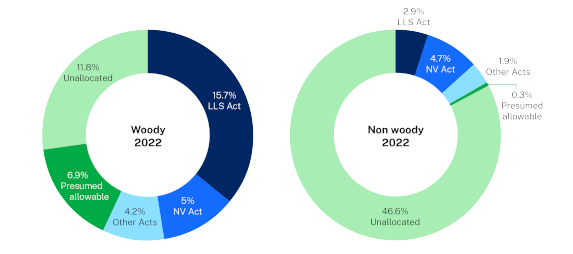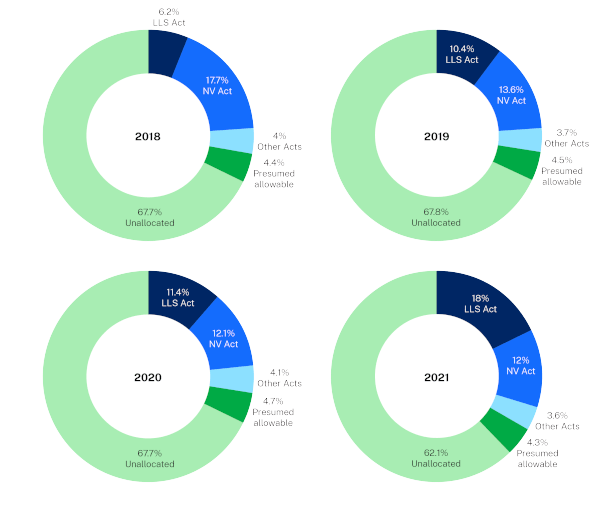Authorising Act approvals include the Local Land Services Act 2013 and other relevant legislation, such as the former Native Vegetation Act 2003. Presumed allowable activities are identified using visual cues.
Unallocated clearing is vegetation clearing for which the Department of Climate Change, Energy, the Environment and Water has not been able to identify a formal authorisation or is unable to presume authorised or allowable using visual cues in the imagery.
To allocate authorisation, clearing is analysed against all available spatial approval data or determined using visual cues in the imagery and additional ancillary data (tenure). No analysis of the characteristics of these activities has been undertaken to ensure they comply with specifications under the relevant Act.
Figure 5 shows clearing authorisation by woody and non woody vegetation structure. The non woody figures do not include the estimated adjustment – see the 'Notes on the non woody method' section.
Preliminary figures for 2022 show that, of the 40,079 hectares of clearing detected on Category 2 regulated land, 42% was recorded as authorised or presumed authorised. Of this, 19% was authorised under the Local Land Services Act 2013 (LLS Act) and 10% under the Native Vegetation Act 2003 (NV Act). A further 13% of clearing was presumed allowable under these Acts or authorised under other legislation.
Of the 58% of all clearing in 2022 that is unallocated, most is non woody vegetation (46%) compared to woody vegetation (12%).
Unallocated clearing refers to:
- lawful clearing or reduction in landcover on Category 2 regulated land that does not require approval, notification and/or keeping of records
- clearing for which the department does not have access to spatial records that authorise or allocate the clearing to a particular land management activity and which cannot be presumed from visual cues in the imagery
- areas that have been potentially cleared unlawfully or are not fully compliant with approvals.
View more information on unallocated clearing.

Figure 5: 2022 vegetation clearing by authorisation and structure Credit: DCCEEW
Possible sources of unallocated clearing include:
- provisions for landholders to remove native vegetation for routine farm management (allowable activities)
- land management activities under the Land Management Code that do not require certification or notification (such as managing woody native regrowth in managed native pastures)
- landholder self-assessment of the level of disturbance of grasslands or ground cover during the transitional period of the Native Vegetation Regulatory Map
- other legislative exceptions.
In some instances, areas of unallocated clearing may be unlawful.
Whether clearing has occurred unlawfully can only be determined by a court of law. Analysis of vegetation clearing each year between 2018 and 2021 by existing and new authorisation categories shows increased clearing under the LLS Act and less under NV Act approvals (Figure 6). Preliminary data for 2022 suggests a continuation of this trend. From 2018 to 2021, approximately 4–5% of clearing was presumed allowable activities, and 4% authorised under other Acts.

Figure 6: Vegetation clearing by authorisation between 2018 and 2021
More information
- SLATS insights dashboardopens a new window
- Approved SLATS spatial data on the SEED portalopens a new window
- Draft Native Vegetation Regulatory map categories
- Unallocated vegetation clearing
- 2022 NSW vegetation clearing data
- Statewide Landcover and Tree Study: woody vegetation clearing
- Statewide Landcover and Tree Study: non woody vegetation clearing